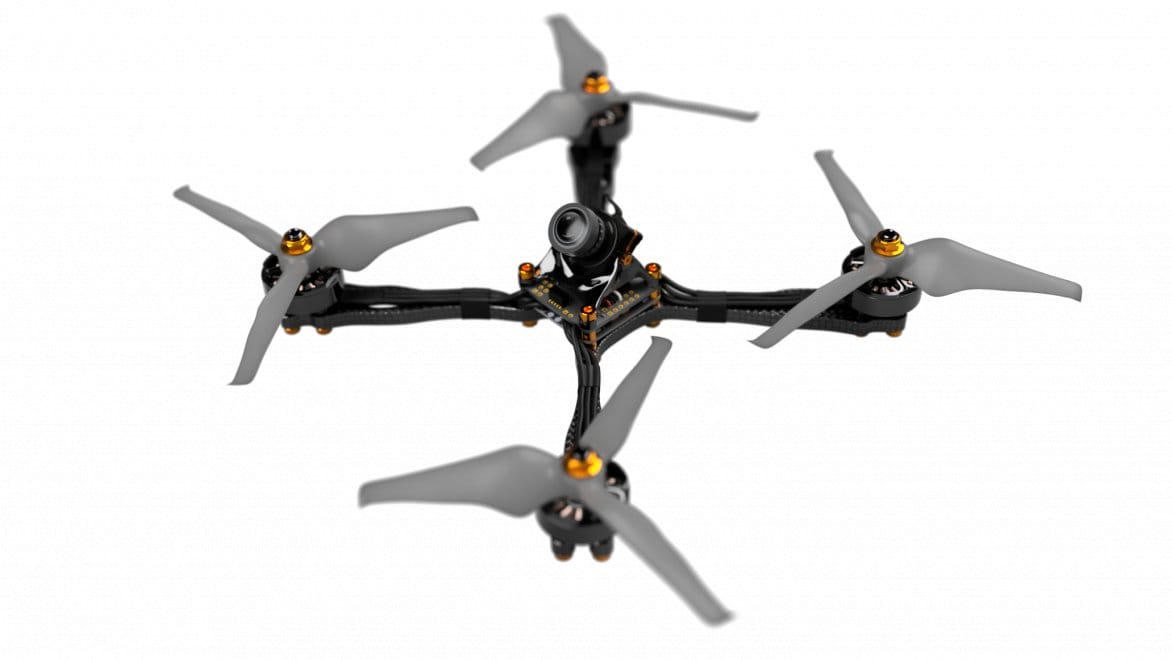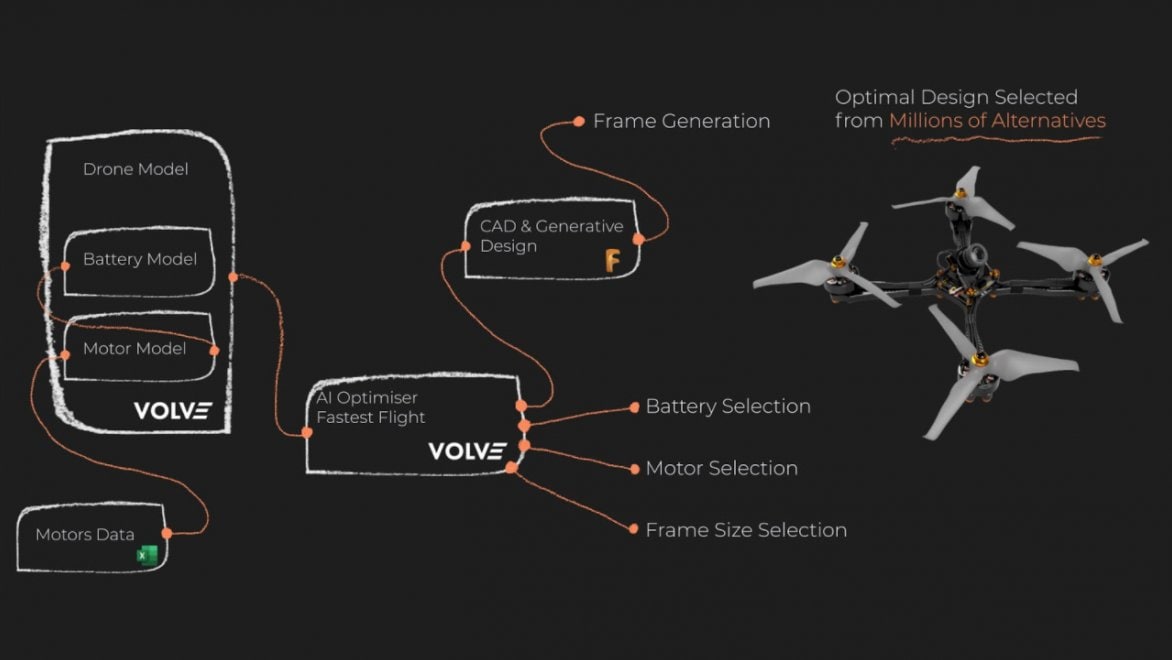VOLVE
Combining AI, simulation, and generative design to optimize racing drones
UTILIZING 2.5-AXIS MILLING CONSTRAINTS
Share this story
Summary
VOLVE combined AI-powered design with flight simulation and generative design tools in Autodesk Fusion 360 to automate the design of a lightweight, high stiffness racing drone frame.

Founders Arkadiy Serezhkin and Ismail Ahmad have developed a proprietary approach to solving engineering challenges using artificial intelligence (AI).
The race is on.
With its distinctive combination of high speeds, intense acceleration, and rollercoaster aerial acrobatics, drone racing is a fast-growing sport among hobbyists and professionals alike.
Unlike conventional drones that are used for surveillance or photography, racing drones are designed to reach speeds up to 100 miles per hour, pull up to 20G loads, and accelerate from zero to 60 mph in half a second. Achieving all of these objectives requires designs that are extremely light yet stiff enough to withstand applied loads and crash landings.
VOLVE is a design and engineering startup aiming to solve these challenges with a proprietary approach to artificial intelligence (AI) together with generative design tools from Autodesk Fusion 360. The company is the brainchild of University College London alumnus Arkadiy Serezhkin and PhD candidate Ismail Ahmad, who pioneered their idea together at an international Unmanned Aerial Systems Challenge in 2018 and have been refining their innovative technique ever since.

Rendering of drone designed in Fusion 360 using generative design. Image courtesy of VOLVE.
Taking a different approach
“Right now, the traditional approach to designing hardware is to focus on a single component,” Ismail, CTO says. “Instead, VOLVE zooms out and optimizes the entire system. For a racing drone, that means asking what motor is the best, what size battery is the best, and how it should all fit together in order to get from point A to point B as fast as possible, with no other design constraints. Bigger motors and batteries deliver more power, of course, but they also have more mass, which could limit the drone’s flight performance. There are many other interlinked parameters to consider as well.”
“After we determine what electronic components are required, we create the structures to house them and withstand the loads in an efficient and lightweight manner,” Arkadiy, CEO says. “The VOLVE AI addresses and optimises the overall system, and through that produces the required geometric constraints.”

Setting up the loading conditions and geometry constraints allows generative design to iterate through different design options and outcomes.
Exploring AI-driven design
What is compelling about the approach of VOLVE is the use of AI for the complete design process from the search of optimal components with its own proprietary algorithms to the geometry generation with the generative design package of Fusion 360. In order to generate the geometry of the frame, VOLVE team needs to determine the appropriate loading conditions.
“The load cases are the most critical factor for maximizing speed,” Ismail says. “If you don’t have the correct loads for generative design, it can’t give you a good result. So we simulate the drone flight through a generic course in order to understand the loads going through the frame and characterize them.”
Specifically, VOLVE runs a virtual simulation of the drone in flight to characterize the acceleration loads for a maneuver, which reveal what loads were applied to the frame and how the motor responded. With this data, it is possible to extrapolate other loads if the drone accelerates a certain amount in a certain direction.

Defining the design criteria and the different options available, VOLVE is able to use artificial intelligence to output optimized designs.
Capturing design parameters
“We know the masses of all the components and the loads of the motors and we use all of that to reverse engineer the loads on everything else,” Arkadiy says.
After millions of simulation runs, the VOLVE team has all the data they need to begin generative design in Fusion 360. This is a much less expensive approach than the alternative, which would involve reproducing, analyzing and prototyping multiple different frame designs.
“Fusion 360 lets us synthesize the geometry for the drone frame,” Ismail says. “Normally, with generative design you have to tell it which components should connect to which other components and then put in all of the loads. Our solution essentially automates all of the work necessary to capture that information up front, and Fusion 360 takes it from there. It’s a fully AI-designed drone.”
Using Fusion 360, VOLVE input the structural and load data for the drone and utilized generative design to create the optimized frame design.
Framing the future
Once the VOLVE team established its structural ideas and loading data for the frame, the next step was letting the Fusion 360 generative design engine produce manufacturable design options. VOLVE used the “explore” option within the software in pursuit of a frame with minimum mass that met the desired stiffness requirement.
“High-end racing drones are built in a modular fashion, so if a motor or arm breaks you can swap them out very easily,” Arkadiy says. “We were going for a design that would be appropriate for a professional racing team. At the same time, we knew that adding a 2.5-axis constraint would help us eliminate mass and maximize stiffness while retaining a reasonable manufacturing cost.”
The frame of the drone was created using carbon fiber layup and machined using 3-axis CNC milling with Fusion 360.
Manufacturing the frame
Fusion 360 produced a variety of designs that met the VOLVE team’s requirements, and they chose the one with the lowest mass. After a bit of design cleanup to ensure the left and right sides were perfectly symmetrical, the design was ready to manufacture. Autodesk helped with this part, creating a carbon fiber layup by bonding two 3 mm plates together and milling it on a 3-axis CNC. With generative design VOLVE was able to decrease the mass of the frame by 2 times, while keeping the same stiffness.
Speeding up innovation
In addition to generative design, Fusion 360 provided finite element analysis (FEA) tools to help VOLVE develop a better understanding of the drone’s natural harmonics, which are directly linked to the stiffness of the frame. Depending on the stiffness, the natural frequency of the frame could interfere with the drones inertial sensors.
“The flight controller always wants to see what the drone is doing, which it senses through the embedded gyroscopes and accelerometers,” Arkadiy says. “But these same sensors pick up the vibration of the frame as well. We want to get the stiffness high enough so that its natural frequency is easily distinguishable from what the flight controller sees. It’s more of a quality check right now but we’re working with it to improve overall performance.”
What is most satisfying for the VOLVE team is knowing that the AI-driven design is very similar to designs human drone pilots have been working on for years.
“We’ve reached the same conclusions as hobbyists who have been experimenting with motor sizes and prop sizes and frame shapes and many other options for three or four years now,” Ismail says. “It seems obvious that the frame should look the way it looks. But our algorithm was able to get there in 20 minutes with no prior knowledge. It’s very exciting.”
Assembled drone using the optimized carbon fiber frame created with generative design.
Taking flight
“I’ve been obsessed with flying things since a very young age, and I’ve been using Fusion 360 as a student for many years,” Ismail says. “It’s very rewarding to develop these new designs and to collaborate with Autodesk to make it happen.”
Now, VOLVE is working on providing access to their AI to engineers in order to improve the way and pace products are developed. Particularly, VOLVE is creating a workflow symbiosis between human engineers that use their creativity to set problems and AI as a computational force to solve them. They are transitioning into the automotive industry to help accelerate development of vehicles.



